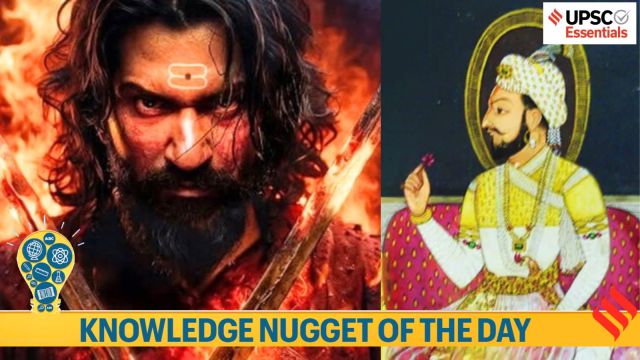
Why in the news?
Vicky Kaushal and Rashmika Mandanna’s historical drama Chhaava hit theatres on February 14, 2025, and has been a box office sensation ever since. The movie is an adaptation of Shivaji Sawant’s Marathi novel of the same name. But why should UPSC aspirants take note of this movie?
Because Chhaava isn’t just another historical drama—it presents the life and legacy of Sambhaji Maharaj, the valiant son of Chhatrapati Shivaji. His reign, policies, military strategies, and resistance against the Mughals are crucial aspects of modern Indian history, polity, and culture, making it a relevant topic for UPSC Prelims and Mains.
Key Takeaways :
1. The eldest son of the celebrated Maratha emperor, Chhatrapati Shivaji, Sambhaji Maharaj was the second ruler of the kingdom after his father’s death. In his short rule spanning nine years, Sambhaji gained recognition for his valour and patriotism. He continues to be celebrated, particularly in Maharashtra, as the ruler who chose death over conversion.
2. He ruled from 1681 to 1689. His rule was largely shaped by the ongoing wars between the Marathas and the Mughal Empire, Siddi of Janjira, Wadiyars of Mysore, and the Portuguese Empire.
3. Among the major military campaigns launched by Sambhaji Maharaj was the attack on Burhanpur, an important Mughal city in present-day Madhya Pradesh and a trading centre. Sambhaji had planned the attack, being aware of Mughal emperor Aurangzeb’s plans to expand into the Deccan. Sambhaji’s attack came as a huge blow for the Mughals.
Story continues below this ad
 The Marathas under Sambhaji also came into conflict with the Abyssinian Siddi rulers who wished to acquire control over the Konkan coast. (Wikimedia Commons)
The Marathas under Sambhaji also came into conflict with the Abyssinian Siddi rulers who wished to acquire control over the Konkan coast. (Wikimedia Commons)
4. Multiple battles took place between the two sides from 1682 and 1688. While the Mughals wanted control over forts held by Marathas, they were not successful.
Battle of Wai
1. In the autumn of 1687, the Mughal and Maratha forces faced each other in the dense forests near Wai and Mahabaleshwar in Deccan India.
2. The Maratha commander-in-chief, and one of the most important supporters of Sambhaji, Hambirrao Mohite, was killed in the Battle of Wai. While the Marathas were victorious in the battle, the execution of Mohite, came a blow to them, and a large number of Maratha troops began deserting Sambhaji. In January 1689, the latter was captured by Mughal forces.
3. There are various historical accounts regarding what happened next, but nearly all indicate that Sambhaji was asked to surrender all his forts and treasures, and ultimately to convert to Islam. Sambhaji refused to comply with these demands and as result was put to a torturous death.
Story continues below this ad
BEYOND THE NUGGET: Ashtapradhan and Important Battles Fought by the Marathas
Ashtapradhan (Council of Eight) was a group of eight ministers responsible for governing the Maratha Kingdom. This system was established by Shivaji. It included:
1. Peshwa: The Prime Minister responsible for overseeing the entire administration.
2. Amatya: The Finance Minister, in charge of managing the Empire’s accounts.
3. Shurunavis: The Secretary who prepared royal orders.
4. Mantri: The Interior Minister, responsible for overseeing internal affairs and intelligence.
Story continues below this ad
5. Sari-i-Naubat or Senapati: The Commander-in-Chief, in charge of the military and defense.
6. Sumant: The Foreign Minister, tasked with managing relationships with other rulers.
7. Nyay Adhyaksh: The Chief Justice, handling civil and criminal justice.
8. Panditrao: The High Priest, responsible for managing religious matters.
Additionally, Chitnis served as the Personal Secretary to the Chhatrapati, acting as a senior writer and often seen as second to the Peshwa in their absence.

Story continues below this ad
Important Battles Fought by the Marathas
Previous Year Questions
(1) Among the Ashtapradhans of Shivaji, who among the following did not hold any military commands besides civil duties? ( Combined Geo-Scientist (Preliminary) Examination, 2025)
1. Peshwa
2. Amatya
3. Sumanta
4. Pandit Rao
Select the correct answer using the code given below.
(a) 1 only
(b) 2 and 3 only
(c) 1 and 4 only
(d) 4 only
(2) Chronologically arrange the following treaties/conventions signed between the Marathas and the British (starting with the earliest): (CDS Exam (I) 2021)
1. Treaty of Salbai
2. Treaty of Purandar
3. Convention of Wadgaon
4. Treaty of Surat
Select the correct answer using the code given below:
(a) 4-2-3-1
(b) 4-3-2-1
(c) 1-3-2-4
(d) 1-2-3-4
(References: Before Vicky Kaushal’s Chhaava, know the real story of Sambhaji Maharaj, Sambhaji Maharaj: Chhatrapati Shivaji’s son whose valour spurred the Marathas)
🚨 Click Here to read the Union Budget Special issue of the UPSC Essentials magazine for February 2025. Share your views and suggestions in the comment box or at manas.srivastava@indianexpress.com🚨
Story continues below this ad
Subscribe to our UPSC newsletter and stay updated with the news cues from the past week.
Stay updated with the latest UPSC articles by joining our Telegram channel – Indian Express UPSC Hub, and follow us on Instagram and X.



 The Marathas under Sambhaji also came into conflict with the Abyssinian Siddi rulers who wished to acquire control over the Konkan coast. (Wikimedia Commons)
The Marathas under Sambhaji also came into conflict with the Abyssinian Siddi rulers who wished to acquire control over the Konkan coast. (Wikimedia Commons)































